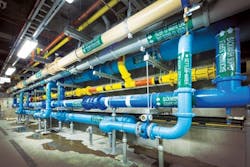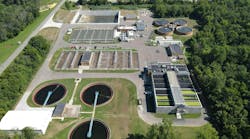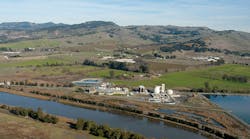Located southeast of Denver, the Parker (Colo.) Water and Sanitation District’s (PWSD) Rueter-Hess Water Purification Facility supplies drinking water to a community of approximately 50,000 residents. The plant is employing a first-of-its-kind treatment process that combines three technologies.
A Renewable Resource
PWSD historically had received its water from non-renewable groundwater basins. In the late 1990s and early 2000s, to supplement this non-renewable supply, the district built Rueter-Hess Reservoir, a 75,000-acre-ft reservoir into which it could divert renewable surface water.
“We didn’t have any way to get [the water] out of the reservoir, which prompted the design and construction of this water treatment plant,” said Pieter Van Ry, director of engineering for PWSD. “At the time we were designing the plant, we didn’t know what water was actually going to go into Rueter-Hess Reservoir, so it was designed in a way that allowed it to be as flexible as possible in its ability to treat varying water qualities.”
PWSD broke ground on the Rueter-Hess Water Purification Facility in October 2012, and the district began delivering water to its customers in July 2015. The plant’s official grand opening was in October 2015.
The plant’s current capacity is 10 million gal per day (mgd), and it comprises three main treatment processes. A high-rate clarification-sedimentation process called Actiflo Turbo uses microsand to enhance particle sedimentation. Then Actiflo Carb, a recirculating powder-activated carbon (PAC) system, handles taste and odor issues and removes contaminants of emerging concern and pharmaceuticals. Finally, a physical barrier process made up of 600 ceramic membrane modules filters the sand and PAC left behind by the previous treatment trains, as well as any remaining particles larger than 0.1 μ.
“The ceramics can handle that kind of grit, whereas with a polymeric membrane system, it would shred the membranes and it would destroy [them],” Van Ry said.
From there, a chlorine contact chamber disinfects the water before it is sent to customers.
The reservoir is fairly new and generally cleaner than some of the older reservoirs in the area. Still, water quality depends largely on where the water is being drawn from within the reservoir itself. In general, the deeper the water, the more challenging it is to treat.
“We have had some weird ammonia issues at the very bottom [of the reservoir], and dissolved metals, iron and manganese mostly,” said Jamie Langer, project engineer for PWSD. “We anticipate having some algae blooms, but we’re working on mitigating that in the summer. We haven’t had too extreme of water quality issues since starting up the plant.”
Ahead of the Game
Although there are a number of PAC systems in place in the U.S., Van Ry said only a handful employ recirculation.
“There are a lot of PAC systems that just inject the PAC and then waste it immediately,” Van Ry said. “This one recirculates it and uses a mass balance equation to add and waste at a particular rate so that we fully utilize the PAC.”
The Rueter-Hess facility uses hydrocyclones to separate waste from the PAC and sand. Waste is disposed of in ponds and the PAC and sand are reincorporated back into the system.
The Rueter-Hess facility is also the first application of ceramic membranes in a North American municipal water system. The facility had to work with the state of Colorado to gain approval for the membranes’ use.
“We were at the forefront of [using this technology] in Colorado,” Van Ry said. “I think part of the national challenge to using ceramic membranes is that the state agencies have no rules or data relative to ceramic membranes. I think that’s part of the next step of making this a more widely utilized technology.”
The plant is designed to expand with the community, which is less than 50% built out, according to Van Ry. It will eventually be expanded to a capacity of 40 mgd, but there is no schedule in place for that yet.
For now, PWSD staff will continue to learn how to cope with the variations in water quality while adapting to the new treatment processes.
“It’s been a tremendous learning curve because not only are we opening a surface water plant, we’re opening a state-of-the-art surface water plant that’s the only one of its kind in the world,” Van Ry said.
Photos courtesy of Dewberry
Download: Here


